This time the aliens try South London instead of East London, and find the locals even tougher!
What’s to like?
The gradually revealed social order amid the outward chaos of the streets, alleys, trash, and detritus of squalid urban life. The additional revelation that for most of the boys in the gang, there is a home to go to but the streets are more exciting.
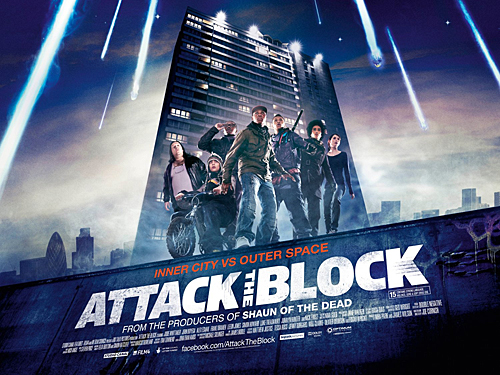
The mix of races and ages. Mugging passers-by is acceptable to the code but not dealing drugs to brothers.
The foul mouthed swearing is for the streets, not when safe indoors among friends. The swearing and cursing is part of the role of the street-tough.
The implicit social criticism. First the bullies and thugs, then the police, then the drugs, then the guns, all sent to destroy the black migrants of south London.
Then come the aliens. No point in calling the police because they will blame everything on the street toughs and lock them up, leaving the aliens to destroy everyone else. When confronted with the pistol-totting drug lord, the police prefer to arrest the street boys. So much easier. No, the boys from the Block have to look after their own, so they arm up and take on the aliens.
The dope growing nerd, Nick Frost, and his nephew prove to be surprising helpful in the denouement. Some basic sciences goes a long way in this script.
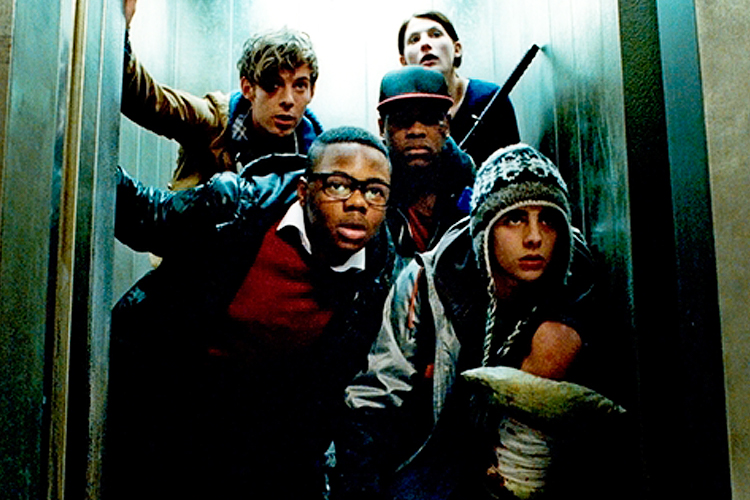
When the newly-moved in nurse tries to explain to the police, who arrive in the end after the street toughs have destroyed the aliens, that the boys saved her and everyone else, the police conclude she has been traumatised by assault, threats, and perhaps rape, Stockholm Syndrome, one officer mutters, while arresting the boys.
The leader of the gang is, by the way, Moses (who led his people to the promised land).
Author: Michael W Jackson
‘Cockneys vs Zombies’ (2012)
From SBS-2 a foul-mouthed slaughter-fest featuring the geriatrics at a nursing home who take on THE ZOMBIES.
I gave it a three and a half snorts rating (four is tops) as I guffawed my way through it.
The nursing home is threatened by a new residential development for the Yuppies who have discovered how handy and cheap East London is. Two grandsons of one of the geriatrics swing into action to come up with the dosh to help out. Their solution is to rob a bank. They assemble a team. This is no A-Team, and includes a klutz, a psycho, an absent minded type, and a cousin who does have some nous. While the lads are busy robbing the bank, the zombies rise and demolish most of the East End.
When the team emerges from the bank, all is devastation. ‘Wh ‘append?, they ask? They are all pretty clueless. But the zombies soon make themselves known. Yes, the have a lot of money now, but who cares! Off they go to save granddad, sure that he will have survived the onslaught, taking along a couple of superfluous hostages who now do not want to be let loose.
What to do? Stay on mission and rescue Granddad.
It is a wild ride and perhaps not best viewed around meal time.
The nursing home includes many familiar faces from Brit cop shows hamming it up, among them Richard Briers who tapes an Uzi to his Zimmer frame, Honor Blackman who knows how to handle a gun, Alan Ford who for years played characters on ‘The Bill’ and similar programs listed in the credits as First Thug, Second Villain, Dudley ‘Tinker’ Sutton whose wheel chair becomes a tank of sorts, and Tony Selby who uses his wooden leg to beat one zombie into pulp.
These seniors have survived Dunkirk, the Blitz, Hitler and World War II, cancer, fifteen years of rationing, the Beatles, divorce, porridge (that is jail time), bell-bottomed trousers, colonial wars, Thatcher, and other catastrophes, a few zombies will not lay them low.
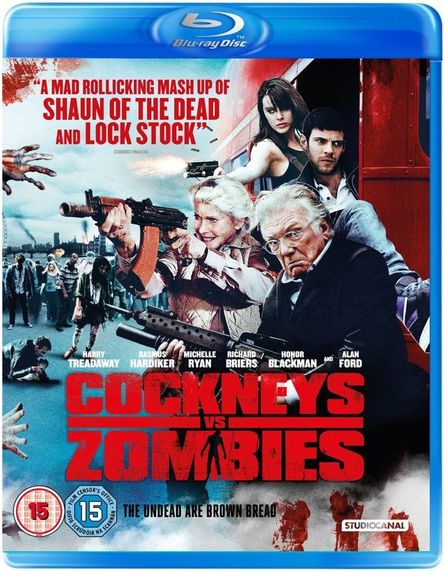
The discerning viewer detects a certain satire here. The Zombies taking over East London surely represent those Yuppies who are driving out the respectable and toiling masses. But then the working class is not spared either, shown to be idle and criminal in the McGuire family.
That it rates a measly 5.9/10 from 14,386 votes on the Internet Movies DataBase confirms a lot about the people to do those ratings, none of it good. There are sixty-eight reviews and I do not recommend reading any of them but I do recommend watching it, though I fear some knowledge of Brit cops shows, personnel, and conventions, will add some seasoning denied those without this background knowledge.
That old tyrant, distance.
One of the sacred text is Australian history is Geoffrey Blainey’s ‘The Tyranny of Distance’ (1966), which made his name and ever after he pontificated on anything and everything until no one (starting with me) listened to him any more. I read it 1974 and not since. The thesis of the book, as I remember, was simple. The great distance of Australia’s English settlements from England made the Europeans in Australia both self-reliant and hostile to, though dependent on, the distant authority because it was unreliable.
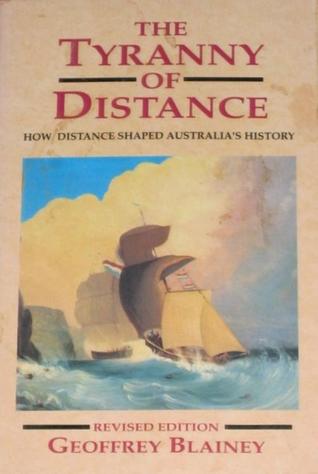
The term ‘tyranny of distance’ pops up now and again in the popular media as it did today in a piece on the business pages of Rupert Murdoch’s organ, ‘The Australian.’ There Bernard Salt (‘The Dallas Line,’ 4 February) told readers that Sydney (which is Australia) is more than a plane ride (with current technology) from much of the world. OK, that is certainly true. No airline flies direct, non-stop from Sydney to London or from Sydney to New York City. This, he contends is detrimental to Australia because that is where the money of the world is. OK, that is also true, but what is the detrimental part? That was not articulated, instead the mantra distance is tyranny was cited. One pictures travellers lugging bags of dosh around inside that London-New York nexus unable to change planes, such is the size of dosh bags, in Los Angeles or Dubai.
The news is, and perhaps this is news to some, that money moves around the world in click of the keyboard as the cascade of financial crises around the world has repeatedly shown. Distance does not insulate any country from such financial calamity. That fact is ritually reiterated on the business page of the organ of Murdoch several times a week. Salt describes himself as a futurist on his web site. Think about that.
By the way, the other side of the tyranny of distance that Blainey mentioned was that in the Eighteenth and Nineteenth Centuries distance did insulate Australia from some of the more dopey and ephemeral fads that came and went elsewhere before they made the trip to Australia. No Edsel or Apple Newton made it to these shores. Not from all such fads but some. It also insulated Australian from some infectious disease epidemics. No more. Bad ideas are replicated here within twenty-four hours.
The distance was measured in travel time as much as miles. Blainey wrote about Australia as remote but of course it was not remote to its aborigine in habitants, nor was it far from the South East Asians who regularly visited the northern shores.
The colonial master in the formative period of Australia’s European history was a long way away in both space and time. It might take, at best, six months to travel from Sydney to London. Moreover, it was unsure. Ships turned back; some were even less fortunate. Others jettisoned cargo, like correspondence, in heavy seas and so the letter went unanswered. When word did come through from London it was so late as to be laughable, fertilising the attitude that authority was remote, anonymous, and stupid.
The result was the Australian political culture of the 1970s, one that entwined a dependence on government for nearly everything from the marketing of eggs to trimming of hedges, while disparaging government and all who worked for it as cretins. Australians wore this anti-authoritarianism with pride, automatically against the government even while waiting for the next handout from it. Rather like a teenage boy rebelling against his parents while pocketing the weekly allowance and storming off to a room provided by the detested parents.
For Australia the first breach in the tyranny of distance was the Boeing long distance jets that supplanted ships for the travel of mere mortals in the 1970s. There followed a generation later the digital world which has shaken many of the most solid institutions like newspapers themselves.
Why read Murdoch’s organ when I can click up BBC News, Le Monde, or Deustche Welle? (My personal answer, since I have been asked this, is the local news that will never make it to these outlets, and the reviews, cultural, and entertainment information. And the nonsense that ever fewer, ever more desperate journalist write, which provides unintended – always the best kind – entertainment. And reading them on paper is still more convenient that on screen.)
When the fad for small government was born on the winds of Proposition 13 (that was referendum for the taxpayers’ revolt in California) in 1978, the spores circled the globe and arrived in Australia rather like the cloud of radiation in Neville Shute’s ‘On the Beach,’ Australians happily shrank government. The one example I witnessed firsthand was the higher education division in the Federal Department of Education which shrank from 400 to 40 to 14, probably 4 now. Each successive government wins office on a pledge to cut government spending, and cut they do. This is now a forty year race to eviscerate government.
Of course a lot of things go wrong as the cuts were made, but as one prime minister said, ‘Not our fault.’ End of that story.
Strangely enough though government has vacated many realms from airlines to docks, the tax bill has not decreased but the automatic anti-authority posturing has decreased so some good has come from it. Though poseurs quickly find other posture to affect, it is true to say.
The French Social Model
We do not hear much about the French Social Model (FSM) these days, now do we? For those who tuned in late or tuned out early, in the first decade of the 2000s the French Social Model was often invoked in hushed and respectful tones, even here in the far antipodes.
When students proposed to do theses on the French Social Model, that was the first I had heard of it. They were getting the message elsewhere. Then at conferences there were sessions that included the FSM. When I returned from a conference in Paris at the OECD, the Master of the Universe to whom I then reported asked about the manifestations of the FSM, in the expectation that they were there to see, I guess, in the streets.
Of course the same people who humbled themselves before this mirage of Gallic sagacity were unsparing critics of the Anglo societies in which they lived. Liberalism was a hoax and democracy a sham in the Anglo-Saxon world.
Of course, few pay into the system.
I had to report to my boss that there were no signs of utopia in Paris between the hotel room and La Défense where the OECD talkfest occurred. (The area is called La Défense because the Prussian Army stopped at that point in 1870, preferring to let the French in Paris kill each other in the Commune. In French mythology the Prussians were fought to standstill. There are people who think they stopped the Germans in 1940, too, at the Pyrenees.)
Then in 2006 there were riots in the streets in the Arab and African quarters of Paris and other French cities. Gulp! It went on and on. There is plenty of video on You Tube for those who need a refresher. The complaints and demands were many.
What French Social Model? A repressive police apparatus, the routine deportation of anyone who complained too conspicuously, withdrawal of the license to publish in some cases. Fifty per cent unemployment because no European French would hire a dark skinned person. Automatic failure in school for anyone name Ahmed. Denial of family reunion immigration. Closure of hospitals in the third world parts of Paris. The list goes on.
It had been going on for decades and was as effective in deluding intellectuals seeking an illusion to go with the fumé blanc and brie as the Soviet Union had been in the 1930s with vodka and black bread. Neither the levels nor means of repression in the two cases are comparable. What is comparable is the readiness of some intellectuals to be deluded by a convenient illusion.
The worship of the FSM has gone quiet of late. Not even the election of the Socialist President François Hollande quite revived it. This accountant from the country has seemed to be in over his head as did his predecessor (who is now lining up to be his successor). The cleanskin Socialist Party has stumbled from one crisis to another, several if its own making.
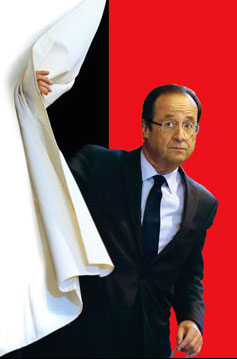 President Hollande
President Hollande
My personal favourite was the Socialist finance minister who pushed for draconian penalties for tax avoidance for all sorts of patriotic and humanitarian reasons. He was undone when his own personal tax avoidance became public knowledge. First he denied the monies existed. Then that the monies were significant. Then that the monies were really his (reaching for his wife as a shield). That it was an oversight. Then…. Then he resigned. Oh, and there was that other financial wizard caught with pants down in New York. Ah, the moral leadership of Socialism. That event thrust Hollande into the leadership.
The point is, for those about to jump to a conclusion, not that the Socialists are any worse than others but that they are no different.
Then in response to terrorists attacks, the Socialist President has declared an open-ended state of emergency. Wow! Imagine if President George W. Bush had done that in 2001! He would have been verbally crucified by the talking-head industry around the world and certainly here in Australia where throwing stones at far-away others is a career. The French attacks were bad, to be sure, but not on the scale of 9/11, but the reaction has been far greater and quicker. Not much of it makes the Australian news in preference to car accidents on the Pacific Highway.
Viewers of TF2 news on SBS see daily reports of continuing police raids, and shoot outs. Dare I call this the Real French Social Model? One suspects that the police have had a long list of villains and now they have the justification to strike at them.
The French Social Model has some adjuncts. The French budget has not be balanced since Valery Giscard d’Estang was president (1974-1981). The debts just keeps on rolling.
One of the biggest drains on the budget is the military establishment which accounts for about 40% of it, which is then used for frequent armed interventions in African, including the Arab countries in North Africa. Those admirers of the French Social Model never pause for long on this prolonged neo-colonialism but one images the outrage if the United States did what the French do. Such are double standards.
 French African Model
French African Model
At any one time France has military units deployed in twenty or more places in Africa. Colonialism or the Gallic Enlightenment?
Freeman Dyson, ‘Disturbing the Universe’ (1979).
Dyson is sometimes said to be the greatest physicist never to win a Nobel Prize, settling instead with having a space craft named for him in ‘Star Trek.’ The book is autobiographical but not an autobiography. Huh?
The essays set forth something of his life and career as a scientist from his first absorption in and simple adsorption of mathematics, to statistical analysis during World War II in Bomber Command, to theoretical work in the Cold War… That is autobiographical part. However it does not offer much of the private man, though we do find out some of his personal life there is no interior, and it is shorn of any reflections on the might-have-beens in his life. The ruminations, and there are a few, are about science and scientists and those they effect or effect them.
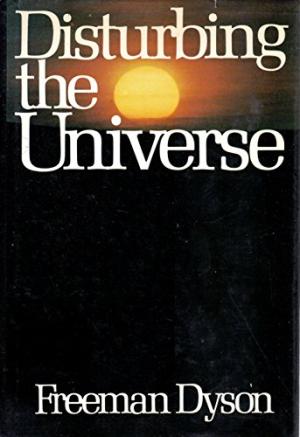
He, by the way, was perhaps among the one million Allied soldiers estimated to be killed in the conquest of Japan, who was saved by the atomic bombs. He had been ordered to Okinawa with a contingent of RAF Bomber Command to join the aerial campaign against Japan in anticipation of a sea landing in November 1946. The Allied planners had assumed one million (1,000,000) Allied causalities to subdue the islands of Japan, based largely not the resistance on Iwo Jima and then Okinawa. He read the news of the first atomic bomb en route to the boat train for the Orient. His orders were altered, and he was demobilised. (The planners also assumed ten times that many Japanese deaths in the conflict and untold numbers later in the devastation of the entire country that would be necessary to subdue it.) The planners also assumed nearly all of these Allied casualties would be Americans, since the other Allies were depleted by the war in Europe and that the Soviet Union would play the waiting game, if for no other reason than in retaliation for the tardy opening of the second front in Europe in 1944. Among the many contingency plans for this operation was, after Japan had been bombed flat, to convert air force personnel to infantry and send them into the charnel house. One such flyboy being converted to infantry in 1945 was my father.
‘The Children’s Crusade’ is the chapter about his RAF experiences. It is an absolutely outstanding account of bureaucratic pathology. I used it a number of times in teaching. The more lies told, the more innocents murdered, the more lives thrown away, the greater the prestige of Bomber Command, the more knighthoods distributed, the larger the budget to continue the mayhem, the less rational analysis occurred. Nothing unique about it, but he lays it all out in a way that is all too familiar.
He started a PhD and sent a year at Cornell University with Hans Bethe, who sent him on to the Institute of Advanced Study in Princeton New Jersey to work with J. Robert Oppenheimer. Many of the Los Alamos scientists, apart from Oppenheimer, had been hired by Cornell. (Chicago got the rest.) Entering their company was exhilarating and frightening to the young Dyson. They had won the Pacific War with their brains, it seemed to him, and now he was one of them, well, not really, but he was among them.
He found Cornell and later the Institute very different from Cambridge where he started the PhD research earlier. First, there was plenty of everything from butter to test tubes and clean, crisp white paper. To a theorist like Dyson, who quickly proved himself so inept at experiments as to be a danger to anyone else working nearby, the clean, crisp, empty white paper was a thrill. (Reminded me of paper elsewhere.) Second, he found the informality of first names, all lining up together for lunch, and sitting at one table different from both the RAF Bomber Command, of course, but also from the class, status, and hierarchy consciousness of Cambridge high tables.
There was another distinguishing feature that stayed with him. The anguish of the atomic scientists at having unleashed the atom. Most days at lunch or coffee someone would talk about it as a moral question, as moral guilt, as a genie that would not go back into the lamp, as the last consuming sin of hubris.
It is in this context that Dyson interprets Fredrick Teller’s fatal testimony against Oppenheimer, and it makes sense in this telling. Oppenheimer was so distraught, feeling ashamed and guilty, stunned, confused by the enormity of nuclear weapons that he had become unstable, volatile, sleepless, haunted, and so was not fit for duty. Teller was trying to make a specific and limited criticism of Oppenheimer’s fitness for the job as director of the Atomic Energy Commission, but in the hysteria of the time and place it got blown out of proportion and Teller never lived down this betrayal of his mentor, doing himself as much damage as he did Oppenheimer. Of course, Teller might well have realised that once he took a public side, it would spin out of his control. Too bad the principals of Wikileaks did not learn from such an example. Once it is out, it is out of control. This is one of many examples in the book of the disservice the media does to reason and rationality with its remorseless, cheap sensationalism.
Toward the middle of the book is the story of Matthew Meselson, a biologist, who won a single-handed victory in the Nixon Administration. Armed with reason and evidence he convinced the National Security Council, which in turn convinced President Nixon, to end military research into chemical and biological weapons: One man with an idea, per John Stuart Mill. Moreover, having renounced CBW (chemical and biological warfare) the Nixon administration convinced the Soviet government to do the same, completely in contradiction to the conventional wisdom. This is a marvellous story which was swamped too soon by the tale of Watergate. In order to slip it past domestic opposition, Nixon played it all so low key many involved did not realise it was done, least of all the sensation-seeking media. No great rhetoric but an achievement for the ages. Dyson was one of the scribes doing the technical work on the reports and proposals that went into this effort.
Nixon also deserves credit for listening to the arguments of Daniel P. Moynihan about cities as per Stephen Hess, ‘The President and the Professor’ (2014) but again, to out manoeuvre opponents on the right, Nixon did so with no fanfare to attract the the attention of the jaded hacks.
Dyson like many of his scientific colleagues drew strength from poetry and music. Indeed he often tried to understand what he was doing by finding poems that expressed it. The same with music. He emerges from this book as a modest and direct individual with a great deal of intellect and capacity for meeting challenges, solving problems, indeed, but not only technical ones.
 Freeman Dyson.
Freeman Dyson.
Lee Hansen first enticed me to read this book, and I used the chapter about Dyson’s experiences in bomber Command many times in teaching to demonstrate the pathologies of large organisations. I lent it to a friend and when he returned it, I opened it and started to read it again. I had thought of it last year when we saw ‘Particle Theory’ about the God-particle, and I noticed the enormous spectacles on the nose of an owlish man in the audience; it was Dyson.
While in the States Dyson did what so many exchange students have done there, including Jacques Chirac, and criss-crossed the country by bus. Dyson chose his destinations according to his finances and the physicists he might meet at the destinations, either by attending lectures or knocking on the office door, things he would never have done in England.
Leena Krohon, ‘Datura’ (2001)
What is reality? What is not? What is the difference? Does it matter?
This is a novel from Finland, read in anticipation of a brief visit there later in 2016. It is charmingly enigmatic and low-key, rather reminding this reader of Finnish movies in those respects.

It is episodic, written in what might be diary entries of a young woman who, after graduating from university, goes to work in the editorial office of a publication called ‘The New Anomalist’ which is a one-man publication that prints only the weird and wondrous; two-headed sheep always get a good run.
Our nameless heroine tries to be nice to the oddballs and weirdos who contribute to the magazine, want to contribute to the magazine, or subscribe to it. Gradually, with constant exposure, they seem less weird and odd to her, and her own normal life seems illusory. Part of the explanation, for the literal minded, is in the title, but I took that mostly to be a metaphor for erosion of her own grasp on reality. Datura is an hallucinogenic.
 Leena Krohon.
Leena Krohon.
While it is set in Helsinki that hardly matters. Mostly the encounters and rumination occur in the dreary one basement office of the magazine which could be anywhere. Ergo, no travelogue.
John Stuart Mill, ‘Auguste Comte and Positivism’ (186?)
I wanted to read this little book (unpaginated) because my efforts—thrice over the years—to read Auguste Comte’s (1798–1857) ‘Système de politique positive’ (six volumes, 1851-1854) failed. While Comte was the centre of much intellectual ferment he has not attracted much attention so I have not come across another exposition. I also thought Mill a good expositor, most of the time.
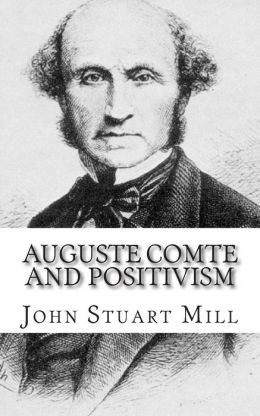
Comte was private secretary to Henri de Saint-Simon, that father of French utopian socialism, in the tag that Karl Marx hung on him never to be shed, who was himself a relative of the diarist Le Duc de St.-Simon of the Sun King’s Court. Moreover, any history of sociology will accord Comte pride of place alongside such giants as George Simmel and Émile Durkheim. George Eliot, the novelist, mentions him in some of her novels in a very favourable way. His name comes up now and again. When I was in Montpelier for a conference I saw a plaque on a school where he was educated. Time to scratch this itch, if only a little.
The ‘Système de politique positive’ offered a philosophy of history that explains humanity’s social evolution through the stages of theological and metaphysical, culminating in the age dawning in 1851, the age of Positivism. These stages take different forms in mathematics, science, the arts, industry and so on, and Comte described them in great detail.
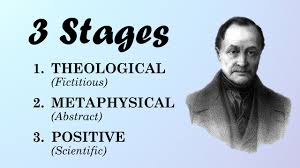 Auguste Comte with the three stages of social evolution.
Auguste Comte with the three stages of social evolution.
In this context ‘positivism’ means a lot more than positive. It means saying only what is demonstrable. He is a materialist after Karl Marx’s own heart. Facts shape ideas, and not vice versa. One of many consequences of this foundation is that reason serves feeling but does not govern it. Herbert Spencer took much of this epistemology on board, and, like it or not, set it forth much more succinctly and clearly than did Comte.
In Comte’s interpretation mathematics is THE science, the foundation of all else, because it is the simplest and sociology is the last science because it is the most complicated. The Wikipedia entry has a potted account that shows signs of the editorial wars for which it is infamous.
Social evolution, per Comte, thanks to Positivism, will lead to a unanimity on all matters, starting with mathematics, by sticking only to the demonstrable. The result is utopia, though Comte does not use the word. Once this unanimity is achieved, then a corporation of philosophers, regarded with reverence, but excluded from political power or material riches, with a modest support from the state, will direct the on-going education (and life) of each individual and the society as a whole. While they have no authority, a sanction from this college of philosopher has a crushing social and moral force. They superintend both the public life and the private life of each and all. They are a panel of very Big Brothers.
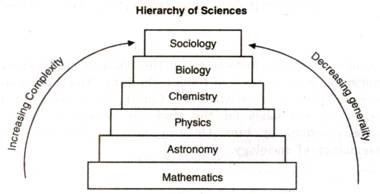 Comte’s hierarchy of the sciences.
Comte’s hierarchy of the sciences.
There co-exists a temporal government which is comprised of an aristocracy of capitalists, led by bankers, seconded by merchants, then manufacturers, and finally agriculturalists. In each case the noun refers to the owners not the workers in these domains. There is nary a word about a role or voice for the multitude who do not own banks, grands magazines, factories, or farms. However, there is completely free discussion. The elephantine six volumes brings forth this rather simple-minded pastiche on Plato’s philosopher-kings. Absent is any mentioned of women, contra Plato. By the way, St. Simon was a banker.
Comte could see no reason why inferiors should elect the superiors who will rule them. Public officials should be responsible for training and selecting their own successors subject only to the approbation of their own superiors. This is a man who believed in hierarchies. A citizen must have a settled career by thirty-five, and after that may not change. This is a man who believed in order at any price. No one may pursue occupations that are not useful. So much for basic research. He was specific about stopping useless research into magnetism, archeology, astronomy, and more. Imagine how popular he would be today with budget cutters. The corporation of philosophers will decide what is useful. End. This corporation will also decide which one hundred, yes, one hundred books will survive and the rest will be burned! One hundred is enough, the rest mere distractions.
Comte regarded rich capitalists as a public functionaries and stipulated that they must act accordingly. Talk about a dreamer. What socialists would achieve by law, Comte hoped to achieve by education and suasion, capped with the peer pressure of public opinion.
Such a result may cause a reader to doubt that it is worth the effort to study the volumes that lead to it in order to understand how Comte arrived at such banalities. So says Mill in one of his drôle asides.
The second half of this unpaginated book is another essay on Comte’s later works which were just as ponderous. Comte took the time to explain his own genius. He never read anything but reflected within himself. Echo Rousseau. The result is an autodidact with a great conviction. He was mentally unstable as a youth, voluntarily spending time in an asylum, and later attempting suicide. In middle age, like Mill, he found the love of his life and told the world. This comparison to Mill’s austere passion for Harriet Taylor might have warmed Mill to Comte.
In the latter works Comte goes even further, devising a social religion that leaves behind the metaphysical and theological claptrap of organised religion and preaches this doctrine and this doctrine alone: live for others. In arriving at this creed, he coined the word ‘altruism.’
‘Live for others’ is literal. One should only do what benefits others. This is not Jesus’s admonition to love neighbours as oneself, but rather not to love oneself at all but only to love neighbours.
Comte was systematic as indicated by the title of the work cited above, and he carried this creed through in everything, from diet (eat only enough to be able to serve others), to dress (simple and utilitarian to serve others), and so on. Everything becomes a moral question settled by this one doctrine. In short, he required that each of us live as a saint practicing self-abnegation in our every act. Followers? He had none. Nor is there any reason to belief he lived as he advocated, rather like most pundits today, he preferred preaching to practicing.
His lady-love died within a year of their conjunction, consequently Comte, like others so bereaved, was attracted to spiritualism. He included guardian angels in his civil religion, and it seemed to be more than a metaphor.
He also proposed an elaborate civil religion with a Pontiff Positive, which would preach the doctrines he proposed. He supported Napoleon III’s coup d’état because it did away with the charade of elective democracy (which Comte always dismissed as the English disease), and predicted that in a few years Napoleon would turn over government to three wise men. Guess who would be the first to be chosen. That day came and went without the magi.
Comte was not a man who knew when to quit. He proposed to give each day of the year a name, to make the week ten-days along, to rename the planets, to change spelling and orthography, spending pages and pages on the evils of diphthongs. (Look it up!)
The more one reads of Aristotle, the more clear is his towering genius. Ditto many others. In the case of Comte, the more one reads, the less one wants to read any more.
Recently I saw on Télévision Française 2’s news broadcast aired by SBS each morning, which I watch for my daily French lesson, the induction of a scholar into the immortals of the Collège de France, the robes, the ritual procession, the pecking order, the props were all very Masonic to this vulgarian. (There were no more than three women; the immortals number one hundred and no one may resign, ergo someone has to die for a new member to be selected.) These individuals are the sort Comte had in mind for rule.
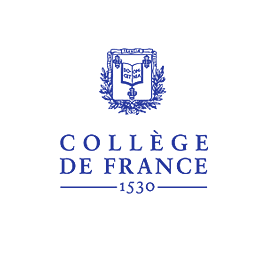 Collège de France logo. I could not find any imagines of a ceremony such as I saw on the news.
Collège de France logo. I could not find any imagines of a ceremony such as I saw on the news.
Of course, while they retain the trappings of veneration, in fact the broadcast had the air of curiosity more than reverence.
This book is not Mill at his best as an exposition. But it soothed my it itch for Comte. Each sentence is a thicket of dependent clauses, noun phases so long that a GPS is needed to find the predicate, encyclopaedic asides, orphaned relative pronouns, that it taxed this reader. In the essays, for which he was paid by the word, Mill is prolix; in his books which he paid for publishing by the word, he is terse. Go figure. His father had Scots ancestry.
Sharyn McCrumb, ‘The Windsor Knot’ (1990)
This title is a krimi set in contemporary rural Georgia in the borderlands with South Carolina and Florida in a small town whose chief denizens are the Chandler family. Belay those stereotypes!
The Chandler sons are an actor of great ambition and little talent, and a physicist who is proud member of the nerd fraternity. Captain Grandfather spend forty years at sea in the navy. Aunt Amanda, had she been available, would surely have repulsed General Sherman at Atlanta with her wit, skill, forceful personality, and the endless supply of contacts in the right places.

Returning to this fold is niece Elizabeth MacPherson, a forensic anthropologist, to be married in the ancestral home. Her unreconstructed hippie parents continue to smoke dope in Hawaii, trusting all arrangements to the Chandlers in residence.
Her beau is a Scots marine biologist; they pass the time with discussions of decomposition rates of flesh.
The plot thickens when local Emmett Martin dies…for a second time. I will say no more to spoil the plot. Suffice it to say it is clever, rIght down to the Biblical nomenclature.
McCrumb is a dab hand at delineating a cast of characters as individuals from all those named above to the several sheriffs and deputies, the scientific colleagues of each of the principals, and the townspeople, including the whole-earth tree-hugging tofu-eating caterers for the wedding whom Amanda suborns into serving flesh. Even the Queen of England and a princess make an appearance!
 Sharyn McCrumb
Sharyn McCrumb
This is the second in the series centring on Elizabeth MacPherson, and I will lay in the first. However not sure about continuing thereafter. With neither zombies nor bimbos, it does not reach the heights of the other books of hers I have read. Being a one-woman industry she also has several other lines of fiction.
Agatha Christie said the secret to finishing was to start. McCrumb got the message.
Alan Sillitoe, ‘The Loneliness of the Long-Distance Runner’ (1959)
This a collection of short stories that opens with the title story of Smith deliberately losing a race in order, as he sees it, to defy the authorities. Winning would have benefited him, but it would also have benefited the warden and jailers of the Borstal where he is held, and rather than do that he loses, and does so in a way that is obvious to viewers.
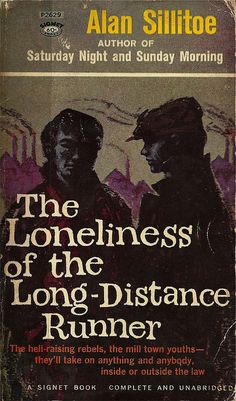
It told from his point of view and is hypnotic at points, especially during the fateful run. Once a reader starts, it draws one in.
Most of the stores have a common theme in loneliness. ‘Uncle Ernest’ is a touching story of a very lonely old man trying to befriend some innocent school girls, which is misunderstand by on-lookers. but who knows, maybe in time, Ernest might …. There is just enough ambiguity to make a reader wonder. No sledge hammer morals here.
‘Mr Raynor the School Teacher’ is another person trapped in his own, very small world, dealing with obstreperous boys, some of whom will find their way to the Borstal nearby. Meanwhile, he daydreams, but never dares speak his mind.
‘The Fishing Boat Picture’ is about love and sacrifice, but all clouded by the inability and unwillingness to communicate. Maybe the characters cannot say what they feel because they just do not know how to do so or they do not quite know what they do feel.
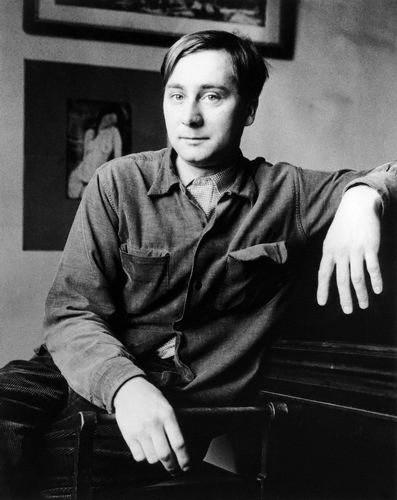 Alan Sillitoe at the time the book was published.
Alan Sillitoe at the time the book was published.
There are four other stories, suffice it to say. I enjoyed reading each of them. Though the petulance does wear thin. Sillitoe was one of the ‘Angry Young Men’ of British letters who found the post-war Welfare State inadequate.
We forget just how long it took Britain to recover from World War II, for example, in meat rationing, petrol scarcity, in employment. It did not enjoy the years of growth and plenty that the United States had during the Eisenhower years. One of the reason the decade of the Swinging Sixties was so liberating was because finally it heralded the end of this wartime privations, that had long ended in other English-speaking countries.
The Wikipedia entry on the story is convoluted and one-eyed, as well as pompous. But it has probably benefited editing twice since I looked at it ten minutes ago.
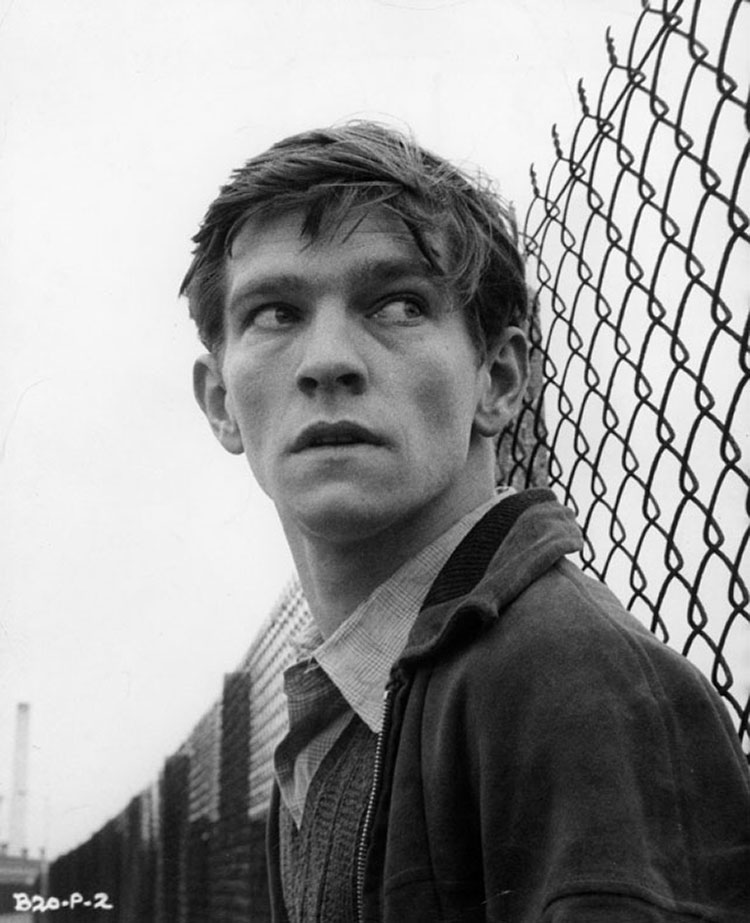 Tom Courteny in a still photograph from the 1962 film based closely on the titular story. I started to type that Courteny was born to play Smith, but then I thought the same about his performance as Ivan in ‘One Day in the Life of Ivan Denisovich (1970).’
Tom Courteny in a still photograph from the 1962 film based closely on the titular story. I started to type that Courteny was born to play Smith, but then I thought the same about his performance as Ivan in ‘One Day in the Life of Ivan Denisovich (1970).’
Another book that turned up during our move.
The Liberal Expectancy
One of the silent assumption of western societies for the last two generations is now undergoing a severe test. Like most assumed truths, it is seldom stated, and certainly not by the talking heads who can never shut up long enough to think.
What assumption is that?
That life in western societies would erode, reduce, and in time eliminate ethnic, tribal, and religious identities and with the passing of these differences, then we can all live together in peace regardless of race, nationality, language. The old conflicts, animosities, hatreds would wash out in the tolerant bath of multiculturalism.
Societies governed by the rationality of the Enlightenment would create the conditions of life in which these superstitions of the past, ethnicity, tribe, and religion, would fall away.
On such assumptions migration was an opportunity not a problem. While migrants will bring in the baggage their ethnic and religious identities with corollary divisions, these will be subdued and written over by their new lives in Western societies, leaving behind their energy, spirit, and creativity.
While the word ‘liberal’ has been as verboten in academic circles as it is in Republican ones, this was one of the core of liberalism. (Strange isn’t it that the self-styled Left of the Academy and the self-styled right of the Republican Party, now represented by Donald Trump, are as one in reviling liberals.)
Another object of revulsion in academic circles for years has been sociologist Daniel P. Moynihan, whose chief sins were calling attention to the implication of social structure and working for Richard Nixon. Just the kind of sell-out to be expected of a liberal! So harrumphed many know-it-alls of my acquaintance. That in both cases Moynihan promoted and acted as a mid-wife to many social programs that benefited millions is irrelevant to the classroom stone-throwers.
Moynihan tried to disabuse us of this liberal expectation that ethnic and religious identities were but flimsy substitutes for the good life and once the good (material) life was in sight, they would retreat into scrapbooks of the past. He argued (‘Beyond the Melting Pot’ [1974], pp 33ff) and he had plenty of evidence at his command in so doing that ethnic identity and religious commitment were essential to the identity of (many, if not most) people and would endure come what may. These identities could withstand the oppression of police states in Eastern Europe, he said, and they could certainly withstand the seductions of Western materialism. A refrigerator would never replace a god. I once saw him more or less drowned out and shouted down at a political science conference advancing this argument. Edifying, not!
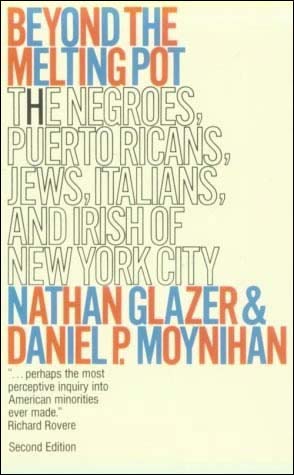
According to this liberal expectancy religion and ethnicity would evaporate in the melting pot of migrant societies. No longer would it be possible to mobilise people by appeals to ethnicity, tribe, or religion. Indeed, one of the silent goals of liberal society was to liberate us from ourselves (our identities as Walloon, Jew, Inuit, Shia, Tatar, Catholic), stripping away these overgrowths and leaving behind the deracinated cosmopolitan.
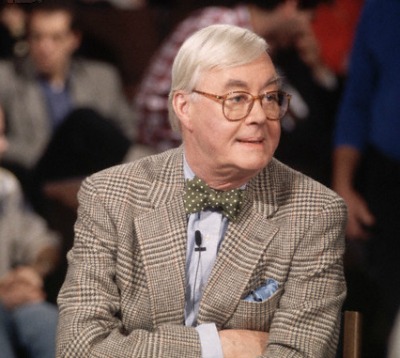 Daniel Pat(rick) Moynihan
Daniel Pat(rick) Moynihan
The resurgence of ethnic nationalism, religion, and tribe in the skeleton of the Soviet Union would come as no surprise to Moynihan, though it did surprise a great many social scientists who are now less conspicuous at conferences. Nor would he be surprised by the continuing response to the appeals of religion everywhere in the world, but most social scientists are baffled by it.
